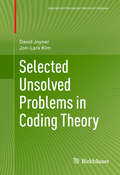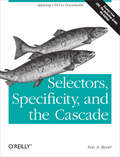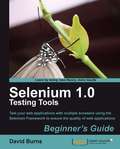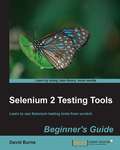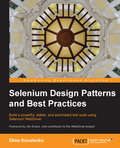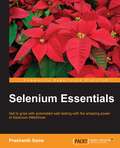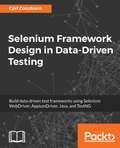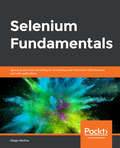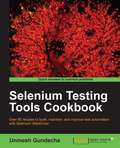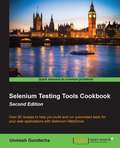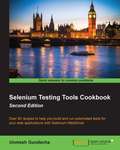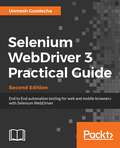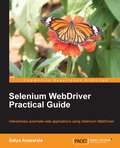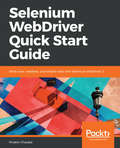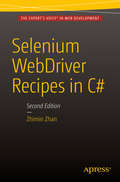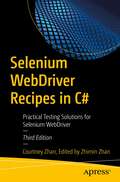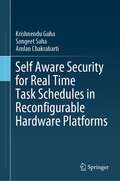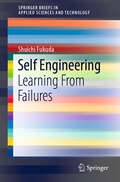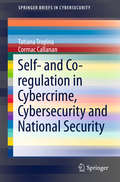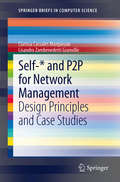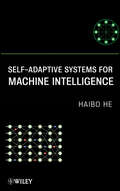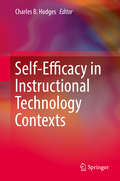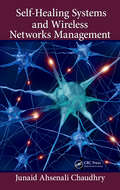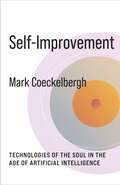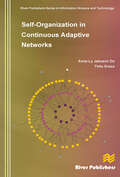- Table View
- List View
Selected Unsolved Problems in Coding Theory (Applied and Numerical Harmonic Analysis)
by Jon-Lark Kim David JoynerUsing an original mode of presentation, and emphasizing the computational nature of the subject, this book explores a number of the unsolved problems that still exist in coding theory. A well-established and highly relevant branch of mathematics, the theory of error-correcting codes is concerned with reliably transmitting data over a 'noisy' channel. Despite frequent use in a range of contexts, the subject still contains interesting unsolved problems that have resisted solution by some of the most prominent mathematicians of recent decades. Employing Sage--a free open-source mathematics software system--to illustrate ideas, this book is intended for graduate students and researchers in algebraic coding theory. The work may be used as supplementary reading material in a graduate course on coding theory or for self-study.
Selectors, Specificity, and the Cascade: Applying CSS3 to Documents
by Eric A. MeyerExactly how does the "cascade" in Cascading Style Sheets work? This concise guide demonstrates the power and simplicity of CSS selectors for applying style rules to different web page elements. You’ll learn how your page’s presentation depends on a multitude of style rules and the complex ways they function—and sometimes collide—within the document’s structure.This guide is a chapter from the upcoming fourth edition of CSS: The Definitive Guide. When you purchase either the print or the ebook edition of Selectors, Specificity, and the Cascade, you’ll receive a significant discount on the entire Definitive Guide when it’s released. Why wait when you can learn how to use selectors and other key CSS 3 features right away?Learn how to create CSS rules that apply to a large number of similar elementsGroup rules to make style sheets smaller and download times fasterUnderstand how elements inherit styles from their parentsDiscover how reader and browser preferences affect your page presentationExamine specificity—the method browsers use to choose between two conflicting style rulesGet a handle on how specificity and inheritance combine to form the cascadeGet details on all of the CSS3 selectors
Selenium 1.0 Testing Tools: Beginner’s Guide
by David BurnsWritten with a fast-paced but friendly and engaging approach, this Packt Beginner's Guide is designed to be placed alongside the computer as your guide and mentor. Step-by-step tutorials are bolstered by explanations of the reasoning behind what you are doing. You will quickly pick up the necessary skills, tips, and tricks for creating successful tests for your web applications with practical examples that help you to learn by experiment and play.If you are a Software quality assurance professional, software project manager, or software developer interested in developing automated testing in web based applications, then this book is definitely for you.
Selenium 2 Testing Tools: Beginner’s Guide
by David BurnsThis book is written in Beginner's Guide style which emphasizes the concept of learning by doing. The book is packed with examples and code so that you can get the best out of this book. If you are a Software Quality Assurance professional, Software Project Manager, or a Software Developer interested in automated testing using Selenium, this book is for you. Web-based application developers will also benefit from this book.
Selenium Design Patterns and Best Practices
by Dima KovalenkoWhether you are an experienced WebDriver developer or someone who was newly assigned a task to create automated tests, this book is for you. Since the ideas and concepts are described in simple terms, no previous experience in computer coding or programming is required.
Selenium Essentials
by Prashanth SamsIf you are a developer who wants to migrate from Selenium RC or any other automation tool to Selenium WebDriver, then this book is for you. Knowledge of automation tools is necessary to follow the examples in this book.
Selenium Framework Design in Data-Driven Testing: Build data-driven test frameworks using Selenium WebDriver, AppiumDriver, Java, and TestNG
by Carl Cocchiaro Pinakin Ashok ChaubalTake a deep dive into building data-driven test frameworks using Selenium WebDriver Key Features A comprehensive guide to designing data-driven test frameworks using the Selenium 3 WebDriver API, AppiumDriver API, Java-Bindings, and TestNG Learn how to use Selenium Page Object Design Patterns and D.R.Y. (Don’t Repeat Yourself) Approaches to software development in automated testing Discover the Selenium Grid Architecture and build your own grid for browser and mobile devices Use third party tools and services like ExtentReports for results processing, reporting, and SauceLabs for cloud-based test services Book Description The Selenium WebDriver 3.x Technology is an open source API available to test both Browser and Mobile applications. It is completely platform independent in that tests built for one browser or mobile device, will also work on all other browsers and mobile devices. Selenium supports all major development languages which allow it to be tied directly into the technology used to develop the applications. This guide will provide a step-by-step approach to designing and building a data-driven test framework using Selenium WebDriver, Java, and TestNG. The book starts off by introducing users to the Selenium Page Object Design Patterns and D.R.Y Approaches to Software Development. In doing so, it covers designing and building a Selenium WebDriver framework that supports both Browser and Mobile Devices. It will lead the user through a journey of architecting their own framework with a scalable driver class, Java utility classes, JSON Data Provider, Data-Driven Test Classes, and support for third party tools and plugins. Users will learn how to design and build a Selenium Grid from scratch to allow the framework to scale and support different browsers, mobile devices, versions, and platforms, and how they can leverage third party grids in the Cloud like SauceLabs. Other topics covered include designing abstract base and sub-classes, inheritance, dual-driver support, parallel testing, testing multi-branded applications, best practices for using locators, and data encapsulation. Finally, you will be presented with a sample fully-functional framework to get them up and running with the Selenium WebDriver for browser testing. By the end of the book, you will be able to design your own automation testing framework and perform data-driven testing with Selenium WebDriver. What you will learn Design the Selenium Driver Class for local, remote, and third party grid support Build Page Object Classes using the Selenium Page Object Model Develop Data-Driven Test Classes using the TestNG framework Encapsulate Data using the JSON Protocol Build a Selenium Grid for RemoteWebDriver Testing Construct Utility Classes for use in Synchronization, File I/O, Reporting and Test Listener Classes Run the sample framework and see the benefits of a live data-driven framework in real-time Who this book is for This book is intended for software quality assurance/testing professionals, software project managers, or software developers with prior experience in using Selenium and Java to test web-based applications.This book is geared towards the quality assurance and development professionals responsible for designing and building enterprise-based testing frameworks.The user should have a working knowledge of the Java, TestNG, and Selenium technologies
Selenium Fundamentals: Speed up your internal testing by automating user interaction with browsers and web applications
by Diego MolinaDiscover how to use Selenium to efficiently test your own applications.Key FeaturesUnderstand the importance of automation with real-world examplesExplore each and every path from configuring an environment to automation with Selenium GridMaster the core concepts of Selenium with 40 exercises and 20 activitiesBook DescriptionThere are several challenges while writing automated tests for web applications: you have to select an adequate test framework, use appropriate selectors to avoid flaky tests, and build a good testing framework. Selenium Fundamentals helps you tackle these challenges and provides you with the knowledge to overcome hurdles in testing by developing stable and effective testing solutions. You’ll learn the complete process of automated testing, such as configuring your environment, creating and running automated tests, analyzing reports, and troubleshooting errors by using a Selenium Grid.To start with, you’ll understand the importance of automating tests. You’ll then move on to understanding how to choose the best selectors for navigating through your web applications while highlighting best practices and techniques.After writing your first tests, you’ll cover the object model to create your own advanced test cases. You’ll analyze a test report, track timing errors, and separate real issues from flaky tests. In addition to this, you’ll learn how to configure and connect to a local grid, a network grid, and a third-party service.By the end of the book, you will have the skills you need to run automated tests on your own web applications.What you will learnGet an overview of SeleniumIdentify what to automate in a project and configure the environmentControl browser behavior and manipulate web page elementsUnderstand the nuances of writing tests and creating test suitesCreate UI tests with Selenium WebDriver and analyze test resultsTroubleshoot errors in automation and build meaningful reportingWho this book is forSelenium Fundamentals is designed for you if you are a software quality assurance and development professional who wants to learn how to automate browser activity and web-based user interface tests with Selenium.
Selenium Testing Tools Cookbook
by Unmesh GundechaThis is a cookbook packed with code examples and step-by-step instructions to ease your learning curve. This book is intended for software quality assurance/testing professionals, software project managers, or software developers with prior experience in using Selenium and Java for testing web-based applications. This book also provides examples for C#, Python, and Ruby users.
Selenium Testing Tools Cookbook - Second Edition
by Unmesh GundechaOver 90 recipes to help you build and run automated tests for your web applications with Selenium WebDriverAbout This BookLearn to leverage the power of Selenium WebDriver with simple examples that illustrate real-world problems and their workaroundsExplains the testing of mobile applications with Appium for mobile platforms such as iOS and AndroidA pragmatic manual with engaging recipes and attractive screenshots to test your web applications efficientlyWho This Book Is ForThis book is intended for software quality assurance/testing professionals, software project managers, or software developers with prior experience in using Selenium and Java to test web-based applications. This books also provides examples for C#, Python and Ruby users.What You Will LearnUnderstand how the locators work and use various locator methods to build reliable testsBuild reliable and maintainable tests with the Selenium WebDriver APIUse the PageFactory pattern to build a robust and easy to maintain test frameworkBuild data-driven tests and extend Selenium API to implement custom steps and checksIntegrate and use ATDD/BDD tools such as Cucumber, SpecFlow, Capybara, and Behave with the Selenium WebDriver APISet up iPhone/iPad and Android simulators and devices to test your mobile web application with AppiumSet up Selenium Grid for faster and parallel running of tests, increasing test coverage and reducing test execution time for cross-browser testingBuild extended Selenium WebDriver tests for additional coverageIn DetailThis book is an incremental guide that will help you learn and use the advanced features of the Selenium toolset including the WebDriver API in various situations to build a reliable test automation. You start off by setting up the test development environment and gain tips on the advanced locater strategy and the effective use of the Selenium WebDriver API.After that, the use of design patterns such as data - driven tests and PageFactory are demonstrated. You will then be familiarised with extending Selenium WebDriver API by implementing custom tasks and setting up your own distributed environment to run tests in parallel for cross-browser testing.Finally, we give you some tips on integrating Selenium WebDriver with other popular tools and testing mobile applications. By the end of this book, you will have learned enough to solve complex testing issues on your own.Style and approachThis recipe-based guide covers real-life scenarios of testing your web apps with Selenium. Each recipe begins with a short introduction and key concepts along with illustrated examples of use cases, and ends with detailed but informative descriptions of the inner workings of the example.
Selenium Testing Tools Cookbook Second Edition
by Unmesh GundechaThis is a cookbook packed with code examples and step-by-step instructions to ease your learning curve. This book is intended for software quality assurance/testing professionals, software project managers, or software developers with prior experience in using Selenium and Java for testing web-based applications. This book also provides examples for C#, Python, and Ruby users.
Selenium WebDriver 3 Practical Guide: End-to-end automation testing for web and mobile browsers with Selenium WebDriver, 2nd Edition
by Unmesh Gundecha Satya AvasaralaReal-world examples of cross-browser, mobile, and data-driven testing with all the latest features of Selenium WebDriver 3Key FeaturesUnlock the full potential of Selenium to test your web applicationsUse Selenium Grid for faster, parallel running, and cross-browser testingTest iOS and Android Apps with AppiumBook DescriptionSelenium WebDriver is an open source automation tool implemented through a browser-specific driver, which sends commands to a browser and retrieves results. The latest version of Selenium 3 brings with it a lot of new features that change the way you use and setup Selenium WebDriver. This book covers all those features along with the source code, including a demo website that allows you to work with an HMTL5 application and other examples throughout the book.Selenium WebDriver 3 Practical Guide will walk you through the various APIs of Selenium WebDriver, which are used in automation tests, followed by a discussion of the various WebDriver implementations available. You will learn to strategize and handle rich web UI using advanced WebDriver API along with real-time challenges faced in WebDriver and solutions to handle them. You will discover different types and domains of testing such as cross-browser testing, load testing, and mobile testing with Selenium. Finally, you will also be introduced to data-driven testing using TestNG to create your own automation framework.By the end of this book, you will be able to select any web application and automate it the way you want.What you will learnUnderstand what Selenium 3 is and how is has been improved than its predecessorUse different mobile and desktop browser platforms with Selenium 3Perform advanced actions, such as drag-and-drop and action builders on web pageLearn to use Java 8 API and Selenium 3 togetherExplore remote WebDriver and discover how to use itPerform cross browser and distributed testing with Selenium GridUse Actions API for performing various keyboard and mouse actionsWho this book is forSelenium WebDriver 3 Practical Guide is for software quality assurance/testing professionals, software project managers, or software developers interested in using Selenium for testing their applications. Prior programming experience in Java is necessary.
Selenium WebDriver Practical Guide
by Satya AvasaralaAn easy- to- follow guide, featuring step-by-step practical tutorials to help you understand how to automate web applications for testing purposes. If you are a quality assurance / testing professional, a software developer, or a web application developer looking to create automation test scripts for your web applications, this is the perfect guide for you! As a pre-requisite, this book expects you to have a basic knowledge of Core Java, although any previous knowledge of WebDriver or Selenium-1 is not needed. By the end of this book, you will have acquired a comprehensive knowledge of WebDriver, which will help you in writing your automation tests.
Selenium WebDriver Quick Start Guide: Write clear, readable, and reliable tests with Selenium WebDriver 3
by Pinakin ChaubalGet writing tests and learn to design your own testing framework with Selenium WebDriver APIKey FeaturesLearn Selenium from the ground upDesign your own testing frameworkCreate reusable functionality in your frameworkBook DescriptionSelenium WebDriver is a platform-independent API for automating the testing of both browser and mobile applications. It is also a core technology in many other browser automation tools, APIs, and frameworks. This book will guide you through the WebDriver APIs that are used in automation tests.Chapter by chapter, we will construct the building blocks of a page object model framework as you learn about the required Java and Selenium methods and terminology.The book starts with an introduction to the same-origin policy, cross-site scripting dangers, and the Document Object Model (DOM). Moving ahead, we'll learn about XPath, which allows us to select items on a page, and how to design a customized XPath. After that, we will be creating singleton patterns and drivers. Then you will learn about synchronization and handling pop-up windows. You will see how to create a factory for browsers and understand command design patterns applicable to this area.At the end of the book, we tie all this together by creating a framework and implementing multi-browser testing with Selenium Grid.What you will learnUnderstand what an XPath is and how to design a customized XPathLearn how to create a Maven project and buildCreate a Singleton driverGet to grips with Jenkins integrationCreate a factory for browsersImplement multi-browser testing with Selenium GridCreate a sample pop-up window and JavaScript alertReport using Extent ReportsWho this book is forThis book is for software testers or developers.
Selenium WebDriver Recipes in C#
by Zhimin ZhanSolve your Selenium WebDriver problems with this quick guide to automated testing of web applications with Selenium WebDriver in C#. Selenium WebDriver Recipes in C#, Second Edition contains hundreds of solutions to real-world problems, with clear explanations and ready-to-run Selenium test scripts that you can use in your own projects. What you'll learn How to locate web elements and test functions for hyperlinks, buttons, TextFields and TextAreas, radio buttons, CheckBoxes, and more How to use Selenium WebDriver for select lists, navigation, assertions, frames, file upload and pop-up dialogs How to debug test scripts and test data How to manage and deal with browser profiles and capabilities How to manage tests for advanced user interactions and experiences (UX) How to work with and manage tests and testing using Selenium Remote Control and Selenium Server Who this book is for This book is for experienced Windows application developers working with . NET and especially C#. Table of Contents 1. Introduction 2. Locating Web Elements 3. Hyperlink 4. Button 5. TestField and TextArea 6. Radio Button 7. CheckBox 8. Select List 9. Navigation and Browser 10. Assertion 11. Frames 12. Testing Ajax 13. File Upload and Pop-up Dialogs 14. Debugging Test Scripts 15. Test Data 16. Browser Profile and Capabilities 17. Advanced User Interactions 18. HTML5 and Dynamic Web Sites 19. WYSIWYG HTML Editors 20. Advanced Topics 21. Selenium Remote Control Server 22. Afterword A. Resources
Selenium WebDriver Recipes in C#: Practical Testing Solutions for Selenium WebDriver
by Courtney ZhanSolve your Selenium WebDriver problems with this quick guide to automated testing of web applications with Selenium WebDriver in C#. This third edition contains hundreds of solutions to real-world problems, with clear explanations and ready-to-run Selenium test scripts that you can use in your own projects. Updated to Selenium version 4, this revision includes Visual Studio Code set up, additional recipes, and new chapters on Selenium DevTools and continuous testing. You'll see how to use Selenium WebDriver for select lists, navigation, assertions, frames, file upload and pop-up dialogs. You'll also learn how to locate web elements and test functions for hyperlinks, buttons, TextFields and TextAreas, radio buttons, CheckBoxes, and more. What You'll Learn Debug test scripts and test data Work with Selenium Remote Control Server Manage and deal with browser profiles and capabilities Monitor tests for advanced user interactions and experiences (UX) Who This Book Is For Experienced .NET and C# Windows application programmers/developers.
Self Aware Security for Real Time Task Schedules in Reconfigurable Hardware Platforms
by Amlan Chakrabarti Krishnendu Guha Sangeet SahaThis book focuses on how real-time task schedules for reconfigurable hardware-based embedded platforms may be affected due to the vulnerability of hardware and proposes self-aware security strategies to counteract the various threats. The emergence of Industry 4.0 has witnessed the deployment of reconfigurable hardware or field programmable gate arrays (FPGAs) in diverse embedded applications. These are associated with the execution of several real-time tasks arranged in schedules. However, they are associated with several issues. Development of fully and partially reconfigurable task schedules are discussed that eradicates the existing problems. However, such real-time task schedules may be jeopardized due to hardware threats. Analysis of such threats is discussed and self-aware security techniques are proposed that can detect and mitigate such threats at runtime.
Self Engineering: Learning From Failures (SpringerBriefs in Applied Sciences and Technology)
by Shuichi FukudaThis book demonstrates how the creation of emotional satisfaction will change in tomorrow’s connected, IoT world. The importance of emotional satisfaction will increase in the IoT Connected Society of World 2.0, in which humans and machines work together as members of the same team with no walls between the two, and where production is also team-based. Developing emotional satisfaction in such a diverse team and in a very different environment is a major challenge and needs to be studied from a broad perspective. This book describes the emerging issues and how they can be to tackled, introducing paths for moving beyond static value toward developing dynamic value.
Self- and Co-regulation in Cybercrime, Cybersecurity and National Security
by Tatiana Tropina Cormac CallananThe ever increasing use of computers, networks and the Internet has led to the need for regulation in the fields of cybercrime, cybersecurity and national security. This SpringerBrief provides insights into the development of self- and co-regulatory approaches to cybercrime and cybersecurity in the multi-stakeholder environment. It highlights the differences concerning the ecosystem of stakeholders involved in each area and covers government supported initiatives to motivate industry to adopt self-regulation. Including a review of the drawbacks of existing forms of public-private collaboration, which can be attributed to a specific area (cybercrime, cybersecurity and national security), it provides some suggestions with regard to the way forward in self- and co-regulation in securing cyberspace.
Self-* and P2P for Network Management
by Clarissa Cassales Marquezan Lisandro Zambenedetti GranvilleThe network management community has been pushed towards the design of alternative management approaches able to support heterogeneity, scalability, reliability, and minor human intervention. The employment of self-* properties and Peer-To-Peer (P2P) are seen as promising alternatives, able to provide the sophisticated solutions required. Despite being developed in parallel, and with minor direct connections perceived between them, self-* properties and P2P can be used concurrently. In Self-* and P2P for Network Management: Design Principles and Case Studies, the authors explore the issues behind the joint use of self-* properties and P2P, and present: a survey relating autonomic computing and self-* properties, P2P, and network and service management; the design of solutions that explore parallel and cooperative behavior of management peers; the change in angle of network management solution development from APIs, protocols, architectures, and frameworks to the design of management algorithms.
Self-Adaptive Systems for Machine Intelligence
by Haibo HeThis book will advance the understanding and application of self-adaptive intelligent systems; therefore it will potentially benefit the long-term goal of replicating certain levels of brain-like intelligence in complex and networked engineering systems. It will provide new approaches for adaptive systems within uncertain environments. This will provide an opportunity to evaluate the strengths and weaknesses of the current state-of-the-art of knowledge, give rise to new research directions, and educate future professionals in this domain.Self-adaptive intelligent systems have wide applications from military security systems to civilian daily life. In this book, different application problems, including pattern recognition, classification, image recovery, and sequence learning, will be presented to show the capability of the proposed systems in learning, memory, and prediction. Therefore, this book will also provide potential new solutions to many real-world applications.
Self-Efficacy in Instructional Technology Contexts
by Charles B. HodgesThis edited volume contains reports of current research, and literature reviews of research, involving self-efficacy in various instructional technology contexts. The chapters represent international perspectives across the broad areas of K- 12 education, higher education, teacher self-efficacy, and learner self-efficacy to capture a diverse cross section of research on these topics. The book includes reviews of existing literature and reports of new research, thus creating a comprehensive resource for researchers and designers interested in this general topic. The book is especially relevant to students and researchers in educational technology, instructional technology, instructional design, learning sciences, and educational psychology.
Self-Healing Systems and Wireless Networks Management
by Junaid Ahsenali ChaudhryDo you believe in open-source development? Would you like to see your security system grow and learn by itself? Are you sick of paying for software license fees every year that produce little return on investment? And, would you prefer to invest in something you could sell later on to other IT security departments? If you answered yes to these ques
Self-Improvement: Technologies of the Soul in the Age of Artificial Intelligence (No Limits)
by Mark CoeckelberghWe are obsessed with self-improvement; it’s a billion-dollar industry. But apps, workshops, speakers, retreats, and life hacks have not made us happier. Obsessed with the endless task of perfecting ourselves, we have become restless, anxious, and desperate. We are improving ourselves to death. The culture of self-improvement stems from philosophical classics, perfectionist religions, and a ruthless strain of capitalism—but today, new technologies shape what it means to improve the self. The old humanist culture has given way to artificial intelligence, social media, and big data: powerful tools that do not only inform us but also measure, compare, and perhaps change us forever.This book shows how self-improvement culture became so toxic—and why we need both a new concept of the self and a mission of social change in order to escape it. Mark Coeckelbergh delves into the history of the ideas that shaped this culture, critically analyzes the role of technology, and explores surprising paths out of the self-improvement trap. Digital detox is no longer a viable option and advice based on ancient wisdom sounds like yet more self-help memes: The only way out is to transform our social and technological environment. Coeckelbergh advocates new “narrative technologies” that help us tell different and better stories about ourselves. However, he cautions, there is no shortcut that avoids the ancient philosophical quest to know yourself, or the obligation to cultivate the good life and the good society.
Self-Organization in Continuous Adaptive Networks (River Publishers Series In Information Science And Technology Ser.)
by Thilo Gross Anne-Ly DoIn the last years, adaptive networks have been discovered simultaneously in different fields as a universal framework for the study of self-organization phenomena. Understanding the mechanisms behind these phenomena is hoped to bring forward not only empirical disciplines such as biology, sociology, ecology, and economy, but also engineering disciplines seeking to employ controlled emergence in future technologies. This volume presents new analytical approaches, which combine tools from dynamical systems theory and statistical physics with tools from graph theory to address the principles behind adaptive self-organization. It is the first class of approaches that is applicable to continuous networks. The volume discusses the mechanisms behind three emergent phenomena that are prominently discussed in the context of biological and social sciences:• synchronization,• spontaneous diversification, and• self-organized criticality.Self-organization in continuous adaptive networks contains extended research papers. It can serve as both, a review of recent results on adaptive self-organization as well as a tutorial of new analytical methodsSelf-organization in continuous adaptive networks is ideal for academic staff and master/research students in complexity and network sciences, in engineering, physics and maths.
